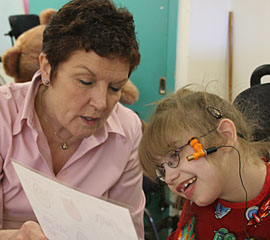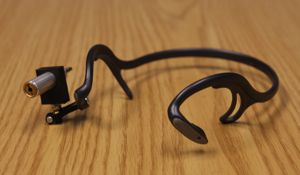Laser Pointer

Melissa Sephton giggles when she turns on her Eeyore toy all by herself. The electronic toy flaps its ears and sings a song whenever the five-year-old girl points her head toward it at a particular angle.
 Melissa is using CanAssist's Laser Pointer, a technology that allows her to turn on the toy simply by pointing the special headband she is wearing in the direction of Eeyore. When a laser attached to her headband is pointed precisely at an activation box on the toy, Eeyore begins his funny routine.
Melissa is using CanAssist's Laser Pointer, a technology that allows her to turn on the toy simply by pointing the special headband she is wearing in the direction of Eeyore. When a laser attached to her headband is pointed precisely at an activation box on the toy, Eeyore begins his funny routine.
Melissa, a Victoria resident with cerebral palsy who has very limited control of her movements, isn't able to use a hand switch for the toy, so CanAssist created a device she can operate by moving her head.
“This device is a really cool thing for a kid,” says Darcy Lane, CanAssist's Hardware Manager. “We turn the laser beam on, the child shines it on the toy, then Eeyore or SpongeBob start dancing around.”
Since the development of Melissa's Laser Pointer - which was designed in consultation with Special Education Technology BC - CanAssist has improved upon this original model. The latest version is much smaller and more discreet than the one Melissa first used.
By mid-2009, CanAssist had provided Laser Pointers to more than a dozen clients with special needs, many of them children. Aside from the sheer pleasure of activating a favorite toy, the device helps youngsters better understand their relationship to the world.
“Some kids don't realize that their actions can cause reactions,” Darcy explains. “This device helps to teach them cause and effect. A teacher or parent says to them, ‘Point your head over here.' When they do, they see the toy turn on and realize that they just did that. It's something very simple for us, but for them it's amazing.”
 To enable an electronic toy to be activated by a laser, the engineers at CanAssist designed a box containing four sensors that detect light. This box is attached to a store-bought toy and, when the laser beam successfully hits the box, a switch is triggered to turn on the toy.
To enable an electronic toy to be activated by a laser, the engineers at CanAssist designed a box containing four sensors that detect light. This box is attached to a store-bought toy and, when the laser beam successfully hits the box, a switch is triggered to turn on the toy.
The pointer itself plugs into another box which gives it power and turns it on and off. For some clients, CanAssist adds a very large button, which also plugs into this box, so they can more easily activate their toy. However, for those like Melissa, who have difficulty using their hands, the laser can be attached to a headband or to the rim of their eyeglasses.
Darcy says the Laser Pointer can be used to activate a wide range of devices, such as lamps, televisions and fans - virtually any appliance that has an on-off switch.
In another very useful application, a teacher can ask a non-verbal child to spell a word. The youngster using the CanAssist device points his or her head toward the appropriate letters displayed on an alphabet chart. For a child who has difficulty holding a stick or pointer, the headband-directed laser beam works wonderfully.
(This technology was first delivered in May 2005. Several clients have since received one.)Go to Top
